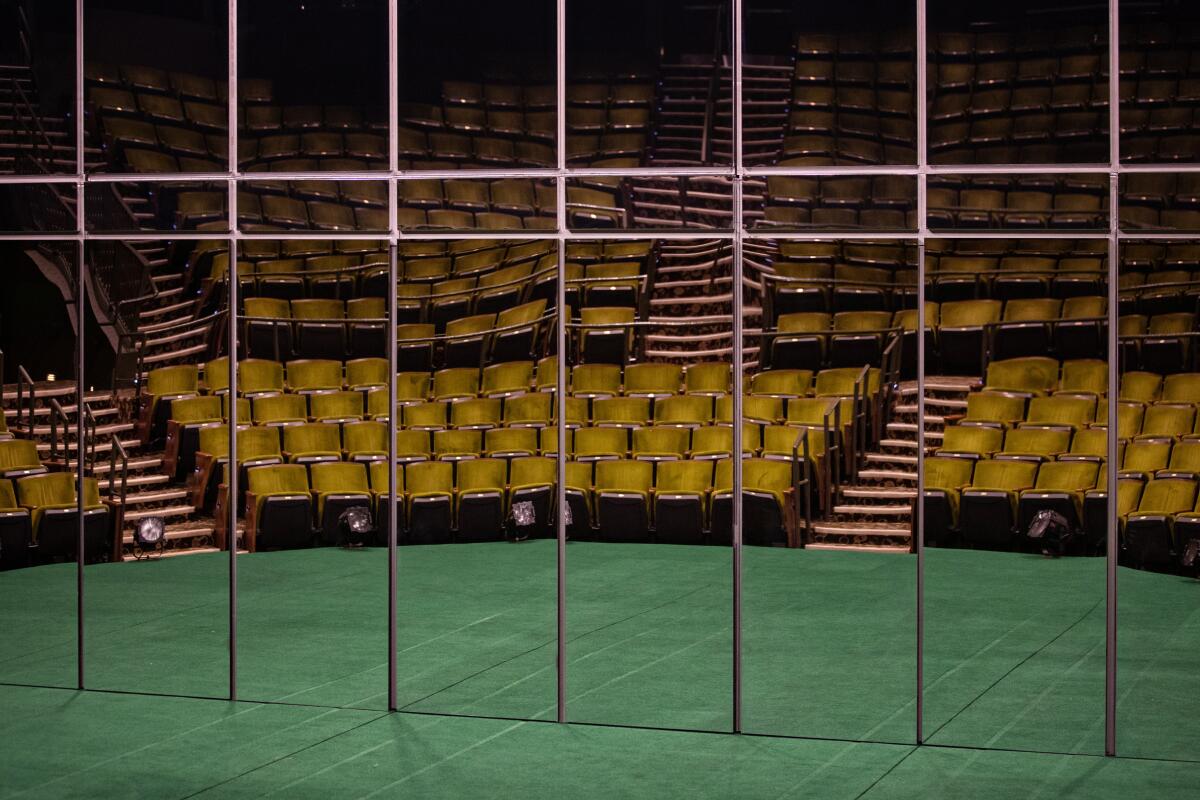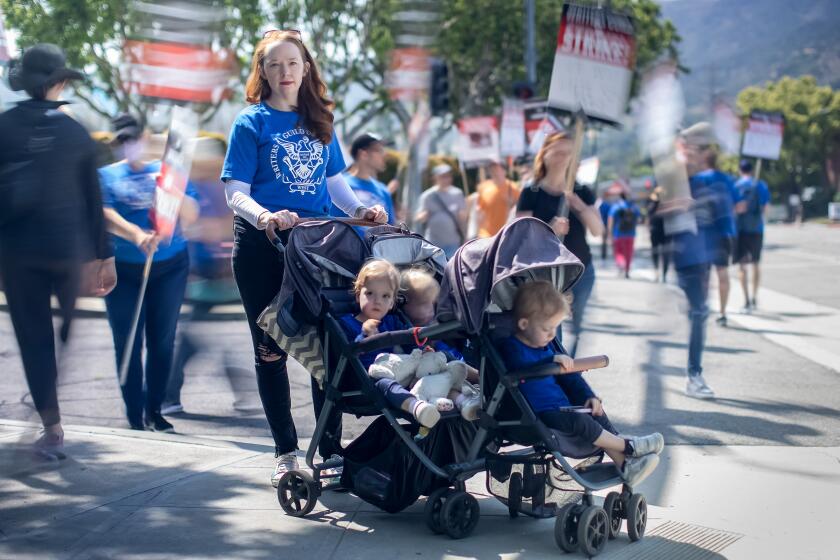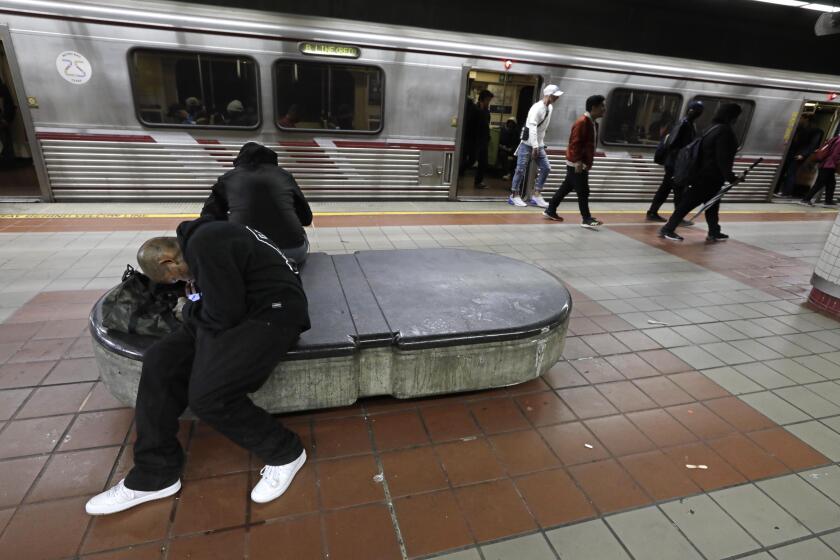California performing arts fell a decade behind in job growth, study finds

- Share via
California’s performing arts sector lost a decade’s worth of jobs within a two-year period, with 2021 employment dropping to 2010 levels, according to a new study. More than 59,000 jobs disappeared during the COVID-19 pandemic that arts leaders say are unlikely to return if drastic action is not immediately taken.
If current trends continue, and employment in the performing arts remains stagnant or achieves only minimal growth, “state and local governments could see a combined $4.1 billion loss in tax revenue over a four-year period,” the study found.
The report, titled “Center Stage: The Role of Live Performing Arts in Revitalizing California Communities,” was produced by CVL Economics — the firm behind the Otis College Report on the Creative Economy — and prepared for the Theatre Producers of Southern California, along with Actors’ Equity Assn. and Arts for L.A., with support from Californians for the Arts.
How is the WGA strike affecting lives? Hear from the mother of triplets, someone who moonlights for LAUSD to make ends meet and three others on the picket line.
“When I saw the report, I just started weeping, because it validated the suffering of the community that I care about and represent,” said Martha Demson, president of the Theatre Producers of Southern California and artistic director of Open Fist Theatre Company. “And I think it had a similar impact on most of my colleagues, just to sit there with the truth that we live, represented in the data.”
That data paints a picture of the devastating effect those job losses have had on California‘s economy. The report notes that for every 100 performing arts jobs, 156 jobs are supported in other sectors — this includes the ecosystems surrounding performing arts centers such as restaurants, shops and parking garages — resulting in $13,287 in additional state and local tax revenue for each performing arts job.
“Not only are the performing arts foundational to the California dream, but they’re also foundational to the bottom line of California,” said Gustavo Herrera, chief executive officer of Arts for L.A., which advocates for equitable access to the arts. “Part of why I think this study is so important is it really does illustrate how California’s live performing arts have been disproportionately affected by COVID-19.”
The groups that commissioned the report hope to use it to persuade the state government to allot $50 million for the Equitable Payroll Fund, otherwise known as Senate Bill 1116, which was passed last year but remains unfunded. The bill, written by Sens Anthony J. Portantino and Susan Rubio, would provide crucial support to struggling performing arts organizations with budgets less than $2 million through the reimbursement of some payroll expenses.
Keith Haring’s first-ever L.A. museum survey, Sondheim celebrations, a groundbreaking Chicanx art show, intriguing Ojai Music Festival offerings and plenty more to check out this summer.
Payroll has been a serious issue for small companies since 2016, when national leaders of the Actors’ Equity Assn. imposed a $9 hourly minimum wage for members who perform in L.A. County theaters with fewer than 100 seats. Before that, actors on such stages were paid stipends that often amounted to a fraction of minimum wage.
The situation became even thornier in early 2020 with the passage of California’s gig economy law, AB5, which made it more difficult for companies to treat workers as independent contractors.
Actors’ Equity President Kate Shindle said getting funding for the bill is crucial to her organization‘s mission to ensure members have access to employment protection, disability coverage and pay.
“These are employers who are trying to do the right thing. They want to comply, they want to be able to pay people, they want to sustain themselves and they just need a little help in getting there. Especially the smaller-size organizations,” said Shindle of the bill’s target demographic.
The CVL survey zeroes in on the pandemic’s effect on small nonprofit theaters with budgets under $3 million. In 2021, earned income from ticket sales and subscriptions for those organizations was nearly 70% below 2019 levels. At larger nonprofits, that same type of income was down 16% from pre-pandemic levels.
The difference in fortunes between small and large nonprofits is particularly glaring when it comes to total revenue, which includes money from secondary sources that include gifts and grants from foundations and the government, and donations from corporations and individuals. For larger nonprofits, total income was actually 19% higher in 2021 than in 2019. During the same period, small nonprofits saw a decline of 32%.
Center Theatre Group has named Snehal Desai as its artistic director, making the East West Players leader the first person of color to helm the organization.
This blow came just as funding from pandemic relief programs, such as the Paycheck Protection Program and the Shuttered Venue Operators Grant, came to an end. The effects of inflation on costs for materials to build sets and food to feed casts, as well rising rent on commercial buildings, have only compounded the crisis. The CVL study notes that rent for industrial properties in L.A. increased by 73% from 2018 to 2023.
Before the pandemic, Demson estimates that there were about 1,200 small performing arts organizations in California. CVL has determined that there are now 860. According to Demson, only about 501 of those organizations are reporting any activity or applying for support.
“The contraction is devastating,” Demson said.
Herrera said some of the struggling organizations are BIPOC-centered and BIPOC-led.
“Sometimes these organizations who are shutting doors don’t have the communications team to really bullhorn that they’re shutting doors, but it’s happening with regularity,” he said. “I think we’ve consistently heard from the field that the situation hasn’t improved.”
The transportation authority’s goal with the classical music is to ‘to restore safety’ at the MacArthur Park station. The music is divisive, with online commentators calling it an inhumane torture tactic.
Demson, Shindle and Herrera all shared stories of friends and colleagues working in the performing arts who have been forced to move out of the state. They said this exodus can’t just be calculated in financial terms, it also represents a form of artistic brain drain. And if it continues, Demson said California may eventually find itself outsourcing its performing arts work to other states.
The stakes could not be higher and the cost of failure could not be greater than they are right now, the arts leaders said. If the downward trend is not reversed, the once vibrant, diverse and socially active performing arts community in the state could very well be pushed to the point of no return, they said.
“My anxiety is that we’re just about there,” Demson said. “Small organizations are canny and creative, and I’m glad we’re still here and we’re still talking. But I don’t think we will have the same conversation a year from now if we’re unsuccessful.”
More to Read
The biggest entertainment stories
Get our big stories about Hollywood, film, television, music, arts, culture and more right in your inbox as soon as they publish.
You may occasionally receive promotional content from the Los Angeles Times.















